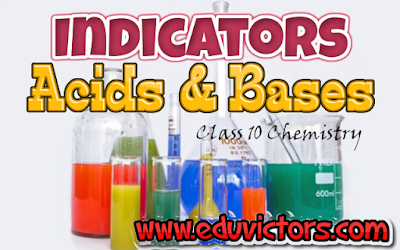Chemistry - Acids and Bases - Indicators
Questions and Answers
Q1: Why there is a need for indicators to test acids and bases?
Answer: It would be too dangerous to taste a liquid to find out if it was acidic or basic. Chemists use substances or dyes called indicators which change colour or odour when they are added to acids or bases.
Q2: What is an indicator? Give examples of indicators.
Answer: An indicator is a dye or substance that changes colour or its smell when it is put into acid or a base. An indicator gives different colours in acid and base. Thus an indicator tells us if the given substance is an acid or base by changing its colour. The three common indicators are: Litmus, Methyl orange, phenolphthalein.
Q3: What are different types of indicators?
Answer: Indicators are of three types:
① Natural indicators
② Synthetic indicators
③ Olfactory indicators
Q4: What are natural indicators?
Answer: These substances are found in plants. Examples are Litmus, red cabbage leaves extract, flowers of Hydrangea, turmeric.
Q5: What is a Litmus?
Answer: Litmus is a natural indicator whose neutral colour is purple. It is made into blue litmus and red litmus for the sake of convenience in detecting colour change when an acid or base is added. This purple dye is extracted from lichen, a plant belonging to the division Thallophyta.
Q6: What are olfactory indicators? Give two examples.
Answer: Those substances whose smell changes in acidic or basic solution are called as olfactory indicators. It works on the principle that when an acid or base is added to it, its characteristic smell cannot be detected. Onion and vanilla extract are olfactory indicators.
Q7: What are synthetic indicators?
Answer: The dye which are prepared artificially are called synthetic indicators. Examples are Methyl orange and phenolphthalein.
Q8: What is a universal indicator?
Answer: It is a mixture of many different indicators(or dyes) which give different colours at different pH values of the entire pH scale. The pH scale was developed by a Scandinavian chemist called Søren Sørenson. Just like litmus, universal indicator can be used in the form of solution or in the form of universal paper indicator.
 |
| pH Paper Colour Chart Credits: Heinrich-Boll-Stiftung, Wikimedia Commons |
Q9: How does vanilla essence act as indicator to detect acids and bases?
Answer: Vanilla essence is an olfactory indicator. It has a characteristic pleasant smell. If a basic solution like sodium hydroxide is added to vanilla essence, then we cannot detect the characteristic smell of vanilla. An acidic solution like hydrochloric acid, does not destroy the vanilla extract. Thus it is used as a test for acids and bases.
LIST OF INDICATORS AND THEIR EFFECTS ON ACIDS AND BASES
| SNo. | Indiactor | Smell or Color in Acids |
Smell or Color in Acids |
|
|---|---|---|---|---|
| Natural Indicator | 1 | Litmus | Red | Blue |
| 2. | Red Cabbage Leaf Extract | Red | Green | |
| 3. | Flower of Hydrangea plant | Blue | Pink | |
| 4. | Turmeric | No Change | Red | |
| 1. | Phenolphthalein | Colourless | Pink | |
| 2. | Methyl Orange | Red | Yellow | |
| 1. | Onion | Characteritic Smell | No smell | |
| 2. | Vanilla Essence | Retains smell | No smell | |
| 3. | Clove Oil | Retains Smell | Loses Smell |
COLOURS PRODUCED BY UNIVERSAL INDICATOR AT VARIOUS PH VALUES
| pH | Colour | pH | Colour |
| 0 | Dark Red | 8 | Greenish Blue |
| 1 | Red | 9 | Blue |
| 2 | Red | 10 | Navy Blue |
| 3 | Orange Red | 11 | Purple |
| 4 | Orange | 12 | Dark Purple |
| 5 | Orange Yellow | 13 | Violet |
| 6 | Greenish Yellow | 14 | Violet |
| 7 | Green |
Q10: You have been provided with three test tubes. One of them contains distilled water and the other two contain an acidic solution and a basic solution, respectively. If you are given only red litmus paper, how will you identify the contents of each test tube?
Answer: If the colour of red litmus paper gets changed to blue, then it is a base and if there is no colour change, then it is either acidic or neutral. Thus, basic solution can be easily identified. Let us mark the three test tubes as A, B, and C. A drop of the solution in A is put on the red litmus paper. Same is repeated with solution B and C. If either of them changes colour to blue, then it is basic. Therefore, out of three, one is eliminated. Out of the remaining two, any one can be acidic or neutral. Now a drop of basic solution is mixed with a drop of each of the remaining two solutions separately and then the nature of the drops of the mixtures is checked. If the colour of red litmus turns blue, then the second solution is neutral and if there is no change in colour, then the second solution is acidic. This is because acidic and basic solutions neutralize each other. Hence, we can distinguish between the three types of solutions.
☛See Also:
Ch2 - Acids, Bases and Salts (MCQs, NCERT Solution, Q & A)
Ch2 - Acids, Bases and Salts (MCQs)
Ch2 - Acids, Bases and Salts (Worksheet)
Ch 2 - Acids, Bases and Salts (Very Short Q A)


No comments:
Post a Comment
We love to hear your thoughts about this post!
Note: only a member of this blog may post a comment.